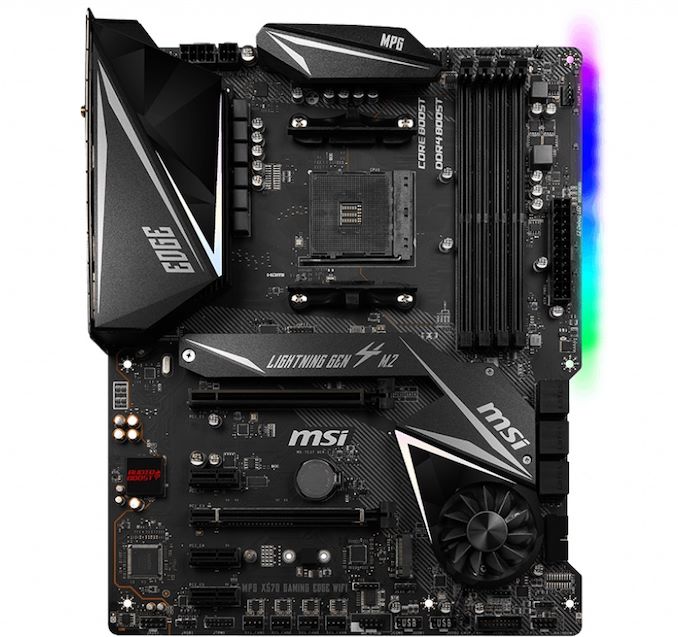The AMD X570 Motherboard Overview: Over 35+ Motherboards Analyzed
by Gavin Bonshor on July 9, 2019 8:00 AM ESTMSI MPG X570 Gaming Edge WIFI
Moving down the product stack and we come to the MSI MPG X570 Gaming Edge WIFI which sits below the X570 Gaming Pro Carbon WIFI with much of the same features, but with a lower-cost controller set. The main features include one PCIe 4.0 x4 M.2 slot, six SATA ports. and an 802.11ac wireless interface. Up to DDR4-4400 is also supported with a total capacity of up to 128 GB across the four available memory slots.
The MPG X570 Gaming Edge WIFI offers a more modest variety of specifications which bridges the gap between the X570 Gaming Pro Carbon WIFI ($259) and the more cost-effective X570 Gaming Plus ($169). Its design is similar to the MPG X570 Gaming Pro Carbon WIFI in that it has a black PCB, but without the carbon inspired decorations on the heatsinks. There are two PCIe 4.0 x4 slots with the top slot including a heatsink, while the bottom slot doesn't, and six SATA ports with support for RAID 0, 1, and 10 arrays. A total of two full-length PCIe 4.0 slots with which run at x16, and x8/x8 with support for two-way AMD CrossFire multi-graphics card setups, and four DDR4 memory slots that support up to DDR4-4400. The two full-length PCIe 4.0 slots operate at x16, and x16/x4 which means NVIDIA SLI isn't supported, but users can utilize two-way AMD CrossFire setups.
On the rear panel is a pre-installed rear panel I/O shield with five 3.5 mm audio jacks and S/PDIF optical output powered by a Realtek ALC1220 HD audio codec. For general connectivity, there is three USB 3.1 G2 Type-A, one USB 3.1 G2 Type-C, two USB 3.1 Type-A, and two USB 2.0 ports. Also present is an HDMI video output for use with compatible AMD Ryzen APUs, as well as a BIOS flashback button, and a PS/2 combo port. Networking wise, there are two antenna ports for the included Intel 3168 802.11ac Wi-Fi interface which is capable of speeds of up to 433 Mbps, while the single Ethernet port is controlled by a Realtek RTL811H Gigabit NIC.
The MSI MPG X570 Gaming Edge WIFI represents a more modest offering in the line-up with an MSRP of $209 which is down to a couple of component choices such as the cheaper Realtek Gigabit NIC instead of the usual Intel variant, as well as no support for NVIDIA SLI configurations.












225 Comments
View All Comments
abufrejoval - Tuesday, July 9, 2019 - link
It's amazing how quickly you run out of PCIe lanes, when you don't have switches to multiplex and translate between PCIe revisions and lanes (e.g. PCIe v4 x2 <-> PCIe v2 x8).I find myself using USB 3.x NBase-T NICs and NVMe adapters, simply because they *do* switch.
Bensam123 - Tuesday, July 9, 2019 - link
Maybe a bit more depth on the power delivery page. I have absolutely no idea how to go about parsing what's there. More chokes is better? What denotes a power phase?A5 - Tuesday, July 9, 2019 - link
+1. Some analysis of that information would be helpful.MrSpadge - Tuesday, July 9, 2019 - link
+1bunkle - Wednesday, July 10, 2019 - link
The controller column includes the total number of phases supported split between CPU cores and SoC e.g. (6+1) = 6 CPU phase and 1 SoC phase. More is *usually* better but has diminishing returns regarding tighter and tighter voltage regulation. Some controllers are better than others (can operate at high frequency e.g. 500KHz v 1000KHz, include other features to improve performance) mitigating the need for more phases.Each phase is a buck converter comprised of a low/high side MOSFET (can be integrated in a single package) and choke. Some controllers can support doubling up the PWM signal to driver more MOSFETs. Doublers can also be added as discrete components if not built into the controller.
Current rating of the MOSFET (e.g. Sic639=40A IR3555=60A) indicates the total power deliverable. MOSFETs are not 100% efficient and vary in efficiency. The more current they provide the hotter they get and the less efficient they become, with better MOSFETs producing less heat for a given current. Thus using doubles can improve temperatures and efficiency without the benefits of the tighter voltage tolerance that *real* phases provide.
Hope that’s helpful!
bunkle - Wednesday, July 10, 2019 - link
A lot more detailed explanation: https://en.wikichip.org/wiki/voltage_regulator_mod...bug77 - Tuesday, July 9, 2019 - link
The description for AsRock X570(M) Pro4 says "5 jack + 1 SPDIF". Unfortunately, those boards lack SPDIF and only come with 3 jacks ;)Smell This - Tuesday, July 9, 2019 - link
I'm thinking the *ASRock Thunderbolt AIC* ...https://thunderbolttechnology.net/product/asrock-t...
would cover all your TBT peripheral needs, including optical.
DanNeely - Tuesday, July 9, 2019 - link
Do X570 boards still need an extra chip per USB port to support USB-C reversibility?The additional expense and needed PCB space were cited as among the reasons why earlier generation boards (IIRC both Intel and AMD) almost never had more than 1 C port; but it was never clear to me if that was an inherent implementation penalty for the C port or an artifact of Intel's tech stack being stalled out and AMD outsourcing to ASMedia which built the chipsets on an ancient (55nm) platform.
DigitalFreak - Tuesday, July 9, 2019 - link
Gavin - X370 and X470 only supported PCIe 2.0. The connection between the CPU and chipset was 3.0, but all the ports on the chipset were 2.0.